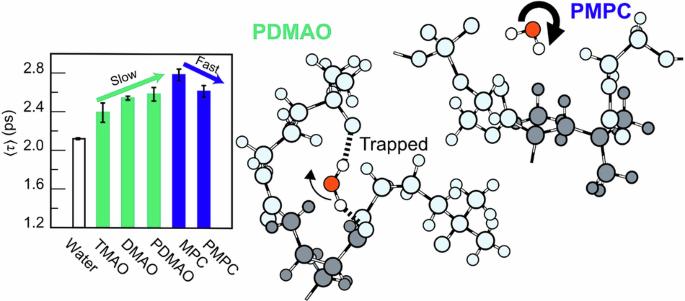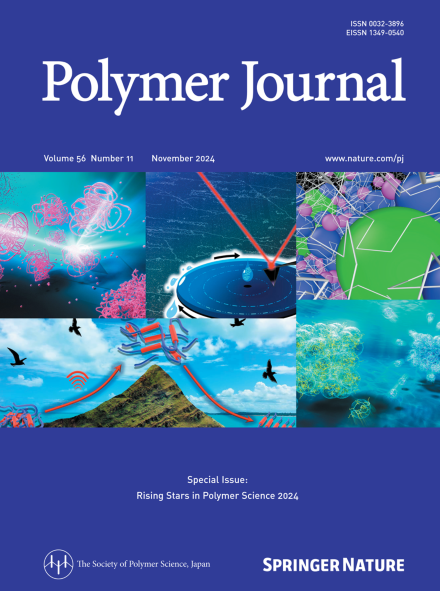两性离子单体聚合对水动力学的影响:由差示扫描量热法和太赫兹光谱支持的分子动力学模拟研究
IF 2.7
4区 化学
Q3 POLYMER SCIENCE
引用次数: 0
摘要
水分子的行为显著影响蛋白质稳定剂和生物材料的有效性。虽然低分子量分子的聚合增强了它们的功能,但聚合物和小分子周围的水合状态和水动力学通常是分开研究的。因此,在分子水平上聚合对水动力学的影响尚不清楚。通过密度功能紧密结合分子动力学(dfft - md)模拟了5种两性离子溶质溶液(三甲胺N-氧化物)(TMAO)、N-[3-(二甲胺)丙基]丙烯酰胺N-氧化物(DMAO)单体、聚(N-[3-(二甲胺)丙基]丙烯酰胺N-氧化物)(PDMAO)、2-甲基丙烯酰氧乙基磷胆碱(MPC)单体和聚(2-甲基丙烯酰氧乙基磷胆碱)(PMPC),研究了聚合对水动力学的影响。DMAO和MPC聚合(分别为PDMAO和PMPC)分别促进水分子的慢速和快速旋转。在PDMAO中,由于水和PDMAO之间形成氢键,水分子被困在侧链之间,导致水动力学缓慢,而在PMPC中,由于聚合导致溶剂可接近表面积的减少,破坏了水分子之间的氢键网络,导致水分子旋转动力学加速。差示扫描量热法(DSC)和太赫兹时域光谱法(THz-TDS)测定的水化量与MD模拟结果一致,这提供了分子水平的见解,促进了目前对小分子聚合中水动力学的理解,从而增强了潜在的功能。描述:聚合对水动力学的不同影响:被侧链捕获的水分子表现出缓慢的动力学,而没有陷阱的水动力学则加速。本文章由计算机程序翻译,如有差异,请以英文原文为准。

Effect of zwitterionic monomer polymerization on water dynamics: a molecular dynamics simulation study supported by differential scanning calorimetry and terahertz spectroscopy
The behavior of water molecules significantly influences the effectiveness of protein stabilizers and biomaterials. Although the polymerization of low-molecular-weight molecules enhances their functionality, the hydration states and water dynamics around polymers and small molecules are typically examined separately. Therefore, the effect of polymerization on water dynamics at the molecular level remains unclear. By density functional tight-binding molecular dynamics (DFTB-MD) simulations of five zwitterionic solute solutions, (trimethylamine N-oxide) (TMAO), the N-[3-(dimethylamino)propyl]acrylamide N-oxide (DMAO) monomer, poly(N-[3-(dimethylamino)propyl]acrylamide N-oxide) (PDMAO), the 2-methacryloyloxyethyl phosphorylcholine (MPC) monomer, and poly(2-methacryloyloxyethyl phosphorylcholine) (PMPC), the effects of polymerization on water dynamics were investigated. DMAO and MPC polymerization (to PDMAO and PMPC, respectively) promote the slow and rapid rotation of water molecules, respectively. In PDMAO, water molecules are trapped between side chains due to the formation of hydrogen bonds between water and PDMAO, resulting in slow water dynamics, whereas in PMPC, a reduction in the solvent-accessible surface area due to polymerization disrupts the hydrogen-bond network among the water molecules, resulting in acceleration of the rotational dynamics of water molecules. The hydration amount determined using differential scanning calorimetry (DSC) and terahertz time-domain spectroscopy (THz-TDS) is consistent with the MD simulation results, which provide molecular-level insights that advance the current understanding of water dynamics in small-molecule polymerization for potential functional enhancement. Caption: A different effect of polymerization on water dynamics: water molecules trapped by the side chains exhibit slow dynamics, whereas water dynamics is accelerated without the trap.
求助全文
通过发布文献求助,成功后即可免费获取论文全文。
去求助
来源期刊

Polymer Journal
化学-高分子科学
CiteScore
5.60
自引率
7.10%
发文量
131
审稿时长
2.5 months
期刊介绍:
Polymer Journal promotes research from all aspects of polymer science from anywhere in the world and aims to provide an integrated platform for scientific communication that assists the advancement of polymer science and related fields. The journal publishes Original Articles, Notes, Short Communications and Reviews.
Subject areas and topics of particular interest within the journal''s scope include, but are not limited to, those listed below:
Polymer synthesis and reactions
Polymer structures
Physical properties of polymers
Polymer surface and interfaces
Functional polymers
Supramolecular polymers
Self-assembled materials
Biopolymers and bio-related polymer materials
Polymer engineering.
 求助内容:
求助内容: 应助结果提醒方式:
应助结果提醒方式:


